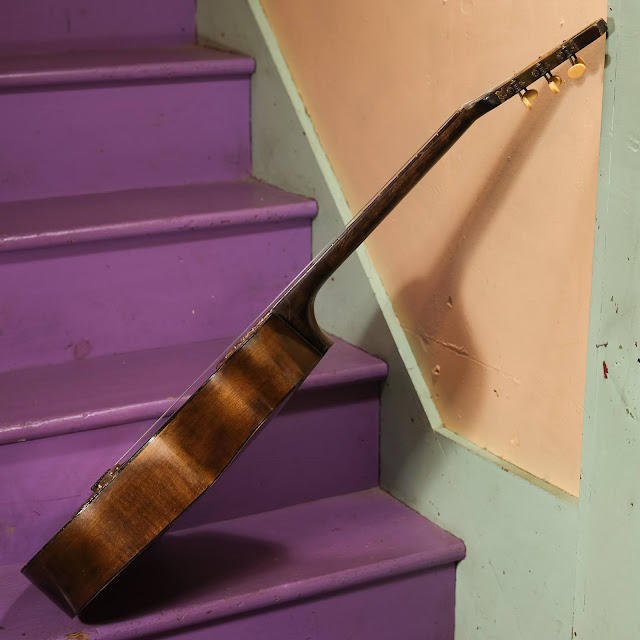1950s Ermalinda Silvestri (Italian-made) Parlor Folk Guitar
While this looks like a prewar guitar and it came in a '30s American chip case, I'm guessing it actually dates to more like the late '40s or early '50s. Silvestri was still making boxes like this around then. If you know better, though, please let me know.
Silvestri was the second-largest maker in Sicily at the time, right after Carmelo Catania -- the brand we see stamped on most Italian-made bowlbacks that you'll find on US shores. Whether this guitar was intended for steel or gut is anyone's guess, but the owner has been running it with classical strings, so that's how I've set it up.
This poor box had been brutalized a bit -- the top has thick varnish added to it, the bridge was gloppily-reglued and funkily-repaired once or twice, and there's a very cool brass insert at the headstock which is a homemade repair of an old break, it seems.
Overall, though, it was close to playability, so after hacking it up a bit over the course of a couple hours, it's now playing bang-on, looks odd and wonderful, and has a very relaxed, "strum me on your porch" sort-of feel. If only I had an espresso and biscotti to enjoy it with, eh?
Repairs included: a fret level/dress and fret seating, much modification of the bridge (including a new weirdo brass saddle that echoes the headstock mods mounted to the front of the bridge because that's where it needed to be to play in tune, sigh-sigh-sigh), cleats for three previously-filled hairline cracks on the top, and a good setup.
Setup notes: the neck is straight, fret height is good, and it plays bang-on with hair-under 3/32" action at the 12th fret.
Scale length: 24 3/4"
Nut width: 1 5/8"
String spacing at nut: 1 3/8"
String spacing at bridge: 2 3/8"
Body length: 17 3/4"
Lower bout width: 13"
Waist width: 8 1/2"
Upper bout width: 10"
Side depth at endpin: 3 3/8"
Side depth at endpin: 3 3/8"
Top wood: solid spruce
Back & sides wood: solid maple
Bracing type: ladder
Fretboard: rosewood, zero fret
Bridge: rosewood-like but not at all rosewood
Neck feel: medium hard D-shape, flat board
Condition notes: there's minor old damage around the seams/binding throughout and old crack repairs to the top and the finish is varnished-over on the top as well. The bridge was a replacement to begin-with and is now modified as well. The headstock has a brass reinforcement repair from sometime in the past as well.
I had to fudge the spacing at the clear-plastic nut to get it working nicely.
So, there's now a (brass) saddle in front of the bridge and mounting is pin-style instead of classical-style. This is because... they put the bridge entirely where it shouldn't have been.



















Comments